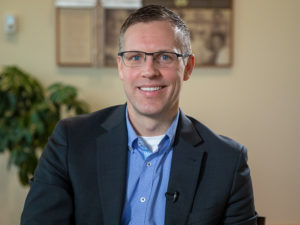Vertical integration will provide needed advantages as nursing homes face mounting clinical and operational challenges, predicts Nate Schema, president and CEO of the Evangelical Lutheran Good Samaritan Society.

Earlier this month, Schema took the helm of Good Samaritan, one of the nation’s largest providers of skilled nursing. He had been vice president of operations since shortly after the organization merged with Sanford Health in 2019.
Schema credits the Sanford partnership with strengthening his organization and ensuring critical access to care during the pandemic. It’s a relationship he is leaning into, considering how COVID, staffing shortages and other pressures have changed long-term care.
“When you come together now with an organization that has critical access hospitals all over the place, 20-plus, and you have four, huge medical centers, doing business looks and feels a little different,” Schema told McKnight’s Long-Term Care News. “What our integrated system has allowed us to do, it’s given us a depth and a bench that we never would have otherwise imagined.”
Integration leads to seamless care
That bench has provided specialists and resources like quick lab results during COVID. It also offers the promise of improved quality and efficiency moving forward. Good Samaritan is centralizing carefully selected functions under the Sanford banner as its nursing homes operate on ever-thinner margins and with fewer residents and staff.
Good Samaritan, for instance, has access to more job candidates through Sanford’s integrated talent solutions system. Systemwide training and onboarding resources help, too.
A new, centralized call center also allows for faster admission decisions. It’s there even when building staff can’t take phone calls from referring hospitals. Now in its infancy, program is only for skilled nursing. But Schema could expand it to aid clustered decision-making around “clear-cut” admissions in assisted living and other settings, too.

“As a leader and an operator, I just want to make sure that every opportunity that crosses our threshold, we’re taking advantage of those things,” said Schema, who oversees facilities in 22 states. “We want to be able to say yes, and say yes quicker and faster. As we’ve seen those through-put and capacity issues on the acute-care side of the house, we know we have to be more responsive and get there even quicker.”
His comments come as more skilled nursing providers feel forced to align themselves with larger operators to remain financially viable. But Schema believes merging can be mutually beneficial.
“I think there are some misconceptions out there around, ‘Now you’re just listening to whatever the hospital folks tell you they need, or what you’re going to do.’ Quite frankly, our experience has been very different,” he said. “There’s been a lot of shared learning and collaboration. Certainly, there’s a much different appreciation for how different post-acute care looks today on my colleagues’ side, and vice versa.”
Technology’s role
Integrating care regardless of location — including in patients’ homes — is a key to Good Samaritan’s growth strategy.
The organization last year piloted an interoperability effort. It allowed skilled nursing’s PointClickCare electronic records systems and acute-care’s Epic system to share patients’ medical information. Testing showed improved efficiency for staff and the potential to improve patient safety during transitions. Now the organization is planning to continue that approach.
Everything is on the table.
Nate schema
There’s also an effort underway to connect residents in rural service areas with consistent care. Last year, benefactor Denny Sanford gave Sanford $300 million, much of it earmarked for a virtual hospital. It will deliver medical services to long-term care residents and community-dwelling patients to help guide treatment of chronic conditions and smooth care transitions.
“Imagine being in rural Iowa and you might be 30 or 40 minutes from the closest critical access hospital, let alone a hospital that might have the specialty or geriatrician that you need being a senior,” Schema said. “Our virtual hospital and command center being built here in Sioux Falls … will allow us to connect with specialties that just aren’t available today. I see it as a way to potentially transform the way care is delivered.”
An abundance of telehealth options sprang up over the last two years. But Schema says skilled nursing would still benefit from versions that operate seamlessly with differentiators like e-prescribing and lab services. Round-the-clock connectivity, monitoring and potential intervention should help reduce hospital visits, lower overall healthcare expenses and improve care outcomes, he adds.
The virtual care center will also be a training ground for nurses and other clinicians supporting seniors.
Financial pressures despite integration
Good Samaritan also continues to integrate programmatic growth opportunities. The system last year opened its first in-house skilled nursing dialysis unit in Sioux Falls, SD. Bismarck, ND, is next, followed by more expansion later in 2022. There is also the possibility of building out palliative and hospice services within the SNF model.
“Everything is on the table for us being connected to our acute-care partners,” Schema said.
But not even being part of a $6 billion health system has insulated Good Samaritan from the financial pressures of the last two years.
At the pandemic’s peak, occupancy dipped about 20% across the organization’s skilled nursing sites. Late last year, Good Samaritan closed three nursing homes in Nebraska, citing occupancy and payment pressure.
“We don’t have the luxury of saying, ‘We’re only going to serve private-pay people today or we’re going to make a strategic move to increase our Medicare volume,’” Schema explained. “When you serve in the types of rural communities like Bottineau and Mulhall, North Dakota, or a Tyndall, South Dakota, populations in the 600 or 700s to 1,500 people, it truly is a mission that we’re serving there. If we don’t see some fundamental changes … we’re going to have continued closures and our quality of care may not look the same.”
Reimbursement is a long-standing issue in many states where Good Samaritan operates. But Schema says funding isn’t keeping up with modern pressures ranging from supply chain problems to inflation and labor shortages. Last year, Good Samaritan spent an additional $15 million on wage and benefit initiatives. But Schema still reports widespread contingency staffing levels.
Seeking short-term fixes
Unlike a corner sandwich shop, providers can’t up their prices and pass wage hikes on to consumers. In Nebraska, Schema and other long-term care leaders recently met with Gov. Pete Ricketts (R). That led to some short-term Medicaid adjustments. Still, Schema says more “Band-Aids” are needed this year.
“There’s this feeling that the pandemic is waning or occupancy is coming back,” said Schema, whose organization has about 8,600 nursing beds, according to the 2021 L/Z 200 listings. “Based on our experience, especially in the Upper Midwest, and where we have a number of locations, it’s going to take time. What we need short-term are some funding solutions and some regulatory relief.”
He pointed to the operational challenges of implementing evolving rules in short-staffed buildings. For instance, Good Samaritan is a strong supporter of COVID-19 vaccines. It was one of the first nursing home chains to mandate them for employees. But Schema is concerned complicated federal enforcement language will lead to different compliance interpretations in different states.
Good Samaritan isn’t waiting for the states and the federal government to hand out solutions.
We’re able to … really make a splash.
nate schema
When it comes to payment, the organization is using its Sanford integration to gain a better foothold in managed care.
“We’re able to bundle those agreements together to really make a splash and push back on some of those managed care agreements that we weren’t able to do as a stand-alone long-term care provider,” Schema said.
Advocacy for the long-term
In his new role, Schema also was tapped to assume an American Health Care Association board seat. In both positions, he succeeds Randy Bury, who retired in late 2021.
“One of our foremost goals for 2022 is to be at the table and using our voice,” Schema says. “In those places where we have a great deal of density — Minnesota, Nebraska, the Dakotas — we’re a phone call away from the governors and those key legislative leaders where we obviously are committed to serving the committees that they’re committed to serving. We believe that we have a little bit more influence and our advocacy carries significantly more weight.”
That density may help predict where Good Samaritan, celebrating its 100th anniversary in September, goes next.
“Where we anticipate our growth being is certainly first and foremost connected to our major hubs in the Upper Midwest: Fargo, Sioux Falls, Bemidji and Bismarck,” Schema said. “Historically, Sanford has been a growth organization, and we’re going to continue to grow. You could expect to see some pretty exciting announcements not too far on the horizon.”



